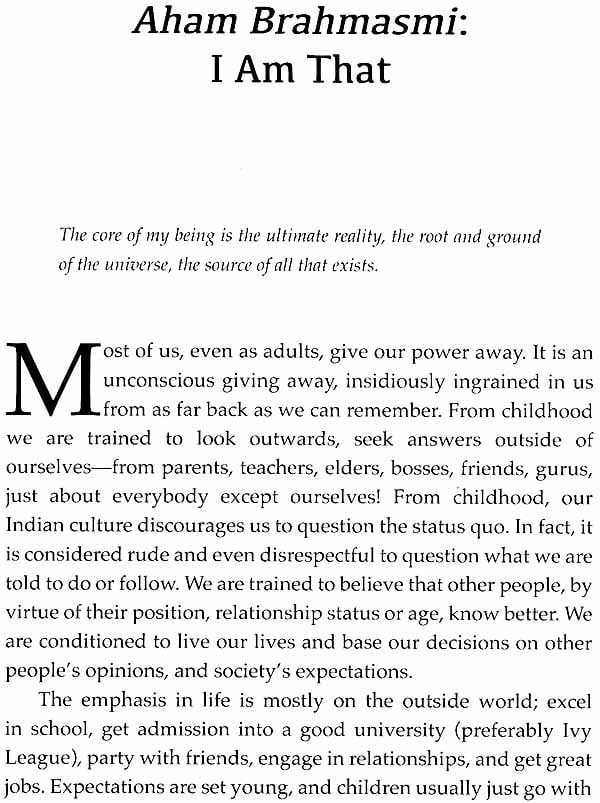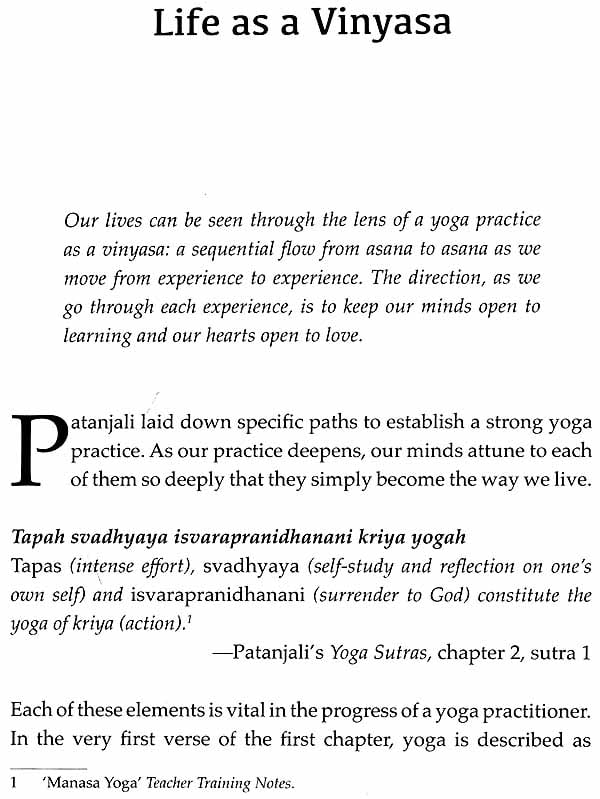
Yoga Shakti - Awaken Your Own Power
Book Specification
| Item Code: | NAH727 |
| Author: | Shailaja Menon |
| Publisher: | Trisha |
| Language: | English |
| Edition: | 2018 |
| ISBN: | 9789386906441 |
| Pages: | 180 (Throughout Color Illustrations) |
| Cover: | Paperback |
| Other Details | 9.0 inch X 6.0 inch |
| Weight | 390 gm |
Book Description
Most people nowadays think of yoga as a class where you learn to twist your body into different asanas. However, the ancient philosophy of yoga is so much more than a mere physical activity, and needs to be better understood in order to fully benefit from it. In Yoga Shakti, Shailaja Menon not only explores the physical benefits of practising yoga, but also the spiritual and mental fulfilment one gains from this practice.
Using personal experience as a driving force, Shailaja explains the origins of Manasa yoga in a way even laymen can understand, and recommends daily exercises to help introduce beginners to the world of yoga. The author discusses how negative feelings like anger, depression, and anxiety lead us to lose the power we have in our own lives, and explores how yoga can help us regain this power and achieve self- realization. This book is the genuine expression of an author who has greatly benefited from practising yoga, and wants to share this knowledge with those who seek to do the same.
Shailaja IS a certified anasa Yoga teacher, speaker, and freelance writer / editor based in Malaysia. She as over 18 years of experience in yoga, both as a teacher and as a practitioner, and teaches at her studio, 'Mat and beyond Yoga Studio' in Malaysia. Her ability to translate the practice of yoga frea thing philosophy and way of life is what makes her classes, writings, and perspectives so insightful. Through this he is able to transform and elevate an individuals life at every level-physical, mental, emotional, and spiritual.
Foreword
Yoga is perhaps one of the most powerful traditions known to us. Across time and culture, the teachings of yogic philosophy have brought tremendous meditative and spiritual solace to its practitioners. Whether in helping deepen our devotion to God or in enriching our service to others, yoga paves a path towards self-realization and contentment that has uplifted individuals and strengthened societies for centuries.
Yet, the discipline also remains poorly understood. Although yoga has seen unprecedented diffusion into popular culture, awareness of its spiritual benefits is often diluted through its contemporary commercialization and politicization. The costs of such distortion are high: as we witness societies fracture across differences and individuals fall victim to new stresses, the need to understand and practice yoga in its truest form is felt acutely. We must remember that the fruits of yoga are borne not only from its physical performance, but in the changes that occur beneath the surface to instil habits of compassion and feelings of peace.
In this context, Yoga Shakti serves as a reminder that is as refreshing as it is vital. By drawing from her own journey, Shailaja reinvigorates the discipline with candour, discipline, and a genuine desire to share the benefits she has herself felt. She communicates the lessons of the Patanjali Sutras to emphasize the spiritual purpose of yoga, in a manner that remains loyal to the intentions of its scholars while being accessible to today's audiences.
In doing so, Shailaja allows readers to navigate their own feelings of agitation, depression, and restlessness, while helping them find direction through the yogic teachings of asana and atha. By exploring the fundamental tenets of yoga, addressing the questions of laymen, and suggesting daily exercises, Yoga Shakti revives the philosophical roots of yoga and provides a comprehensive guide that enlightens both the curious and the informed. I thoroughly recommend it to all who seek self- realization through the power of yoga.
Yoga is a vast subject with diverse philosophies coursing through it. In our system, Manasa yoga, we focus primarily on the dualistic Yoga Sutras of Patanjali, the non-dualistic Advaita Vedanta of Adi Shankaracharya, and the non-dualistic doctrines of Kashmir Shaivism. Etched out in the architecture of these great edifices of amazing insights are beautiful maps which reveal the entire topography of consciousness. The two poles which we generally find in these maps would be of samsara (entanglement and suffering) on one end, and samadhi (wisdom and liberation) on the other. Samsara refers to the repeated cycles of life, a place of entanglement and suffering, and samadhi refers to a series of insightful absorptions which disentangles us and liberates us from this endless cycle of suffering.
Generally, the context of liberation points to a release from the mundane world and an absorption into the supramundane. However, this binary view of dystopic immanence and utopic transcendence is not the direction of our system of yoga. What we really want is for students to understand the maps of yoga teachings, which will then reveal the terrains of their own consciousness, and help them realize where they currently operate from.
Here, the schematic framing of thought patterns and capacities into the unwholesome (ashuba vasanas) and wholesome (shuba vasanas) help us to sharpen our capacity of discernment. With this sharpened sword of intellect (viveka), we can sever the tentacles of self-defeating thought patterns (samskaras) which were only raised in ignorance (avidya), and subsequently allow for the blossoming of wholesome patterns which serve in helping us reach our highest potential.
So instead of focusing on being released from the different recurring challenges of life (samsara), the yoga practitioner finds himself / herself learning from each cycle, getting enriched in the process, and being able to conduct themselves more skill fully. Not only do they not suffer, but they are able to deeply relish the gift of embodied life. And in the whole process, the student's awareness and perception expands to not only sense the body and mind, but also the presence of a hierarchically organized order of underlying energy and intelligence, much like the famous ontological concepts of the explicate order and the implicate order of the great theoretical physicist David Bohm.
As we walk this path, in what was previously the immanent, we experience the transcendent. Instead of liberation, we celebrate our individuality. We reclaim our true power. This is the direction which Shailaja will take you through this book.
Shailaja first walked into my class around 15 years ago. She had already been practicing yoga for several years before coming to our studio. Perhaps the focus of the Manasa yoga system, in the simultaneous threading of each asana with precise biomechanical considerations along with transformational philosophical contemplations, is what intrigued and inspired her, and kept her coming regularly to my classes. In this period I saw her transform, from a student keen on the shape aspects of asana to a very contemplative practitioner, probing deep into both physique and psyche to experientially realize the various coalesced states of mind and body, action and reflection, Siva and Sakti, Jiva and Atma, in short-consciousness and energy. Her explorations, along with the different in sights she received while going through the crucible of life is evident in her writing. These insights will help anyone going through the different challenges that life offers. I end my note with this share of a line of the great Tantric mystic Kshemaraja, who sang in ecstasy-' dharanitahsadantamsivaya, everything in this universe, from the mundane to the supra mundane, from the waste on the pavement to the deity in the sanctum sanctorum, are all refractions of the ONE great light.'
May we too be able to sing the same, rejoicing in our inherent oneness while respecting the apparent differences between us. It is with great pride that I write this Preface for her book. I wish Shailaja and all the readers of this book the very best.
Contents
| Acknowledgements | 9 |
| Foreword | 11 |
| Preface | 13 |
| Aham Brahmasmi: I Am That | 19 |
| Exploring Yoga | 33 |
| Awareness | 53 |
| Atha: Being in the Now | 63 |
| Tanu: Thinning, Letting Go | 73 |
| Suffering Through the Lens of Kleshas | 85 |
| Meeting Suffering | 101 |
| The Grandeur of Vairagya | 117 |
| Alignment | 133 |
| Life as a Vinyasa | 147 |
| Follow Your Bliss | 159 |
| Why Should We Practice Yoga? | 171 |
| References | 177 |













